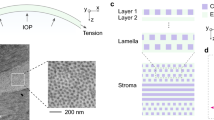Abstract
The cornea is birefringent, and the birefringence can be easily observed in a living eye. For observation, a reflection polariscope is used, the iris serving as a reflector. Some sick people have grossly different and easily identifiable photoelastic patterns from the patterns observed in healthy subjects. The possibilities of a new clinical diagnostic method through the use of photoelasticity is discussed.
Similar content being viewed by others
Author information
Authors and Affiliations
Rights and permissions
About this article
Cite this article
Zandman, F. Photoelastic effect of the living eye. Experimental Mechanics 6, 19A–22A (1966). https://doi.org/10.1007/BF02327314
Issue Date:
DOI: https://doi.org/10.1007/BF02327314




